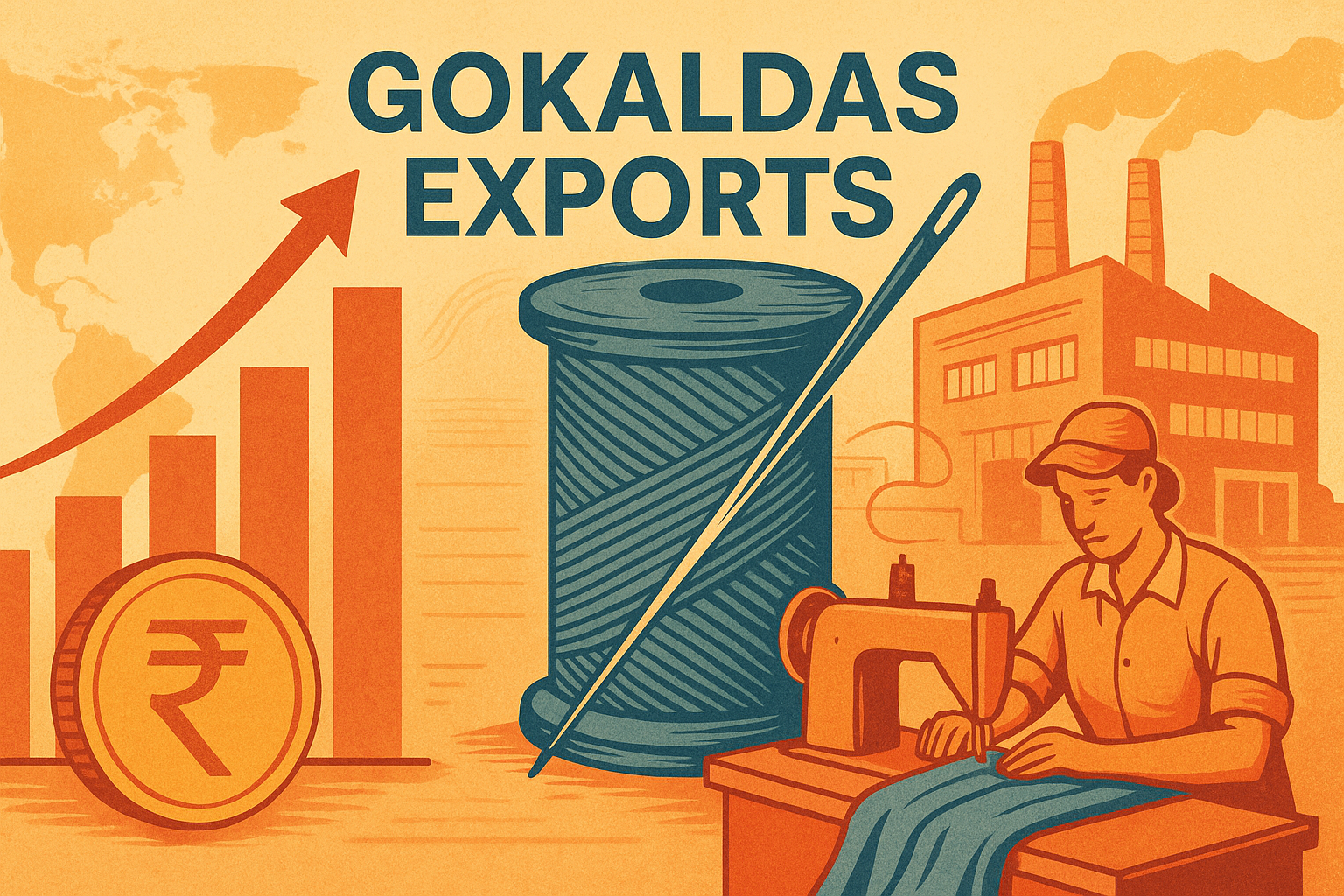Shares of Gokaldas Exports Ltd have surged 13% over the past month, reflecting investor optimism amid a confluence of sectoral and policy tailwinds. However, beneath this buoyant surface, financial vulnerabilities hint at a complex narrative. Here’s a deep dive into what’s fueling the rally, the lurking risks, and whether Gokaldas Exports’s momentum can endure.
Policy Tailwinds Powering the Surge
1. Trade Relief and Free Trade Agreements
The textile sector recently gained significant momentum from two major policy shifts:
- 90-Day Pause on US Reciprocal Tariffs: A temporary suspension of tariffs by the US on Indian exports promises a short-term uplift in competitiveness, particularly beneficial to companies like Gokaldas Exports, which draws over 75% of its revenues from the American market.
- India-UK Free Trade Agreement (FTA): Concluded on May 6, 2025, after three years of negotiations, the FTA will eliminate the 8-12% import duties on Indian textiles and garments entering the UK. This levels the playing field against competitors like Bangladesh and Vietnam and could double the UK’s contribution to Gokaldas’s revenue. Currently, the UK market contributes around ₹250 crore annually, or about 5% of Gokaldas’s total revenue.
This agreement, once fully implemented in late FY26, positions Gokaldas Exports to exploit a potential $1 billion incremental export opportunity to the UK, driven by an expected 12% cost advantage over Chinese competitors.
2. Bangladesh Garment Import Restrictions
India’s decision to channel ready-made garment imports from Bangladesh through only two ports—Kolkata and Nhava Sheva—could indirectly bolster domestic players by improving their pricing power. For Gokaldas Exports, this means a potential edge in the competitive landscape.
Scaling Ambitions: Capacity Expansion and Acquisitions
1. Aggressive Expansion Plans
To capture growing demand, Gokaldas Exports is expanding its production footprint:
- Bhopal, Madhya Pradesh: Phase I of a new sewing facility with 1,100 machines is near full capacity. Phase II is expected by end-June 2025.
- Karnataka: A new plant under construction will add another 750 machines.
- Ranchi, Jharkhand: A leased unit housing 200 machines (effectively 400 with two shifts) focused on knitwear production.
- Atraco Expansion: An additional 500 machines being added at this acquired UAE-based entity.
Collectively, these expansions are projected to add around ₹480-495 crore in annual revenue by FY26.
2. Strategic Acquisitions
Recent acquisitions include:
- Atraco (UAE): Expanding global reach and cost-competitive production.
- Matrix Clothing Pvt. Ltd (India): Diversifying into high-value knitwear.
- BRFL Textiles Pvt. Ltd (BTPL): With ₹175 crore invested via optionally convertible debentures, Gokaldas aims to bring BTPL up to industry standards. Capacity utilization at BTPL has improved to 40-45% from near zero.
These moves are aligned with the company’s long-term target to scale revenues to $1 billion (₹8,500 crore), up 120% from FY25 levels.
The Cracks Beneath the Surface
1. Margin and Profitability Concerns
Despite strong revenue growth—from ₹1,790 crore in FY22 to ₹3,864 crore in FY25—Gokaldas has struggled to maintain margins:
- Operating Margins: Increased only modestly from 8.4% in FY21 to 9.6% in FY25.
- Net Profit Margins: Fluctuating between 2% and 7%.
- Peer Comparison: Page Industries and KPR Mill Ltd boast operating margins of 18-21%, reflecting superior cost structures.
Return ratios remain modest:
- ROE: 9.4% versus Page Industries’s 48.5% and Vedant Fashions’s 23%.
- RoCE: 11.8% against peers’ 26-59%.
2. Rising Leverage
Borrowings have surged from ₹154 crore in FY23 to ₹845 crore in FY25, raising the debt-equity ratio to 0.41x. Though manageable, interest costs have tripled, squeezing net margins further. Near-term margin pressure is expected to continue, with a 200 basis point decline projected before any recovery from late FY26.
3. Promoter Pledging: A Red Flag
Promoter ownership stands at a low 9.38%, with a staggering 96.3% of these shares pledged as collateral. Such high pledging exposes shareholders to risks of forced selling if stock prices decline, creating volatility.
Institutional Interest and Market Sentiment
Domestic institutional investors (DIIs) and foreign institutional investors (FIIs) have been steadily increasing their stakes:
- DIIs: From 25.46% in June 2022 to 36.82% in March 2025.
- FIIs: From 10.97% to 25.79% over the same period.
Brokerage firm Sharekhan maintains a ‘buy’ rating on the stock, highlighting robust medium- to long-term prospects despite acknowledging near-term headwinds like US tariff uncertainties.
Conclusion: High Risk, High Reward
Gokaldas Exports sits at the intersection of favorable macroeconomic shifts and aggressive growth strategies. The easing of trade barriers, capacity expansions, and strategic acquisitions provide a powerful runway for future growth.
However, margin pressures, a rising debt load, and high promoter pledging present significant risks that investors cannot overlook.
Bottom line: Gokaldas Exports offers a compelling growth story, but it’s a bumpy road ahead. For investors, the stock demands a keen eye on operational execution, financial health, and market dynamics to ensure that today’s rally translates into sustainable, long-term returns.


